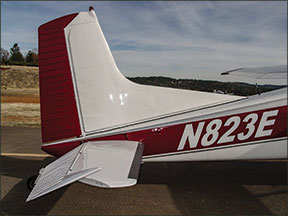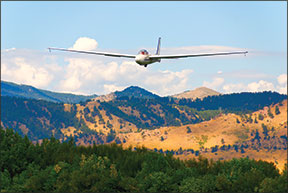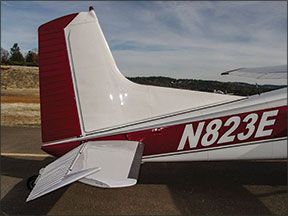In his seminal book Stick and Rudder, Wolfgang Langewiesche states the rudder “…causes the greatest difficulty for beginners,” and “….even the more experienced pilot often has trouble using it correctly.” Commenting on improper rudder use as a contributing factor in accidents, he states, “In the typical fatal accident, which involves a stall and a spin, misuse of the rudder is almost always partly to blame….”

After a short-field takeoff, the Cessna 172 was pitched to a high angle of attack (AoA) to maintain best-angle-of-climb speed (VX). At 100 feet agl, the left wing dropped slightly, then the airplane rolled left, eventually rolling inverted. It crashed in a nose-down attitude, killing the pilot.
How Did That Happen?
Remember the momentary left wing drop? The pilot tried to correct it with right aileron. Rather than correctly employing opposite rudder (pressure on the right rudder pedal in this example) when the left wing first lowered, the pilot incorrectly lowered left aileron when he applied right aileron, stalling the left wing and leading to the inadvertent spin to the left. This hypothetical power-on stall-spin accident scenario illustrates how improper rudder use may have deadly consequences.
During nearly 15 years as a flight instructor, I’ve observed many pilots with poor rudder skills. A large number of them, including student pilots in training, allowed slipping and skidding turns, failed to correct for adverse yaw during turns; and applied insufficient or no right pedal rudder pressure to keep the slip-skid ball centered while pitched up following takeoff and during slow-flight maneuvering. Additional problems include using inadequate rudder to level the wings while demonstrating power-on and power-off stalls, and improper use when performing forward and side slips.
Improper rudder skills may be a contributing factor in many inadvertent stall-spin accidents. For example, the following real-life incident happened to me, contributing to an inadvertent spin. While conducting a flight review in a Cessna 172, I requested the pilot demonstrate a power-on stall. At the time, the airplane was in level flight at 5000 feet agl, airspeed was 110 KIAS, and cruise power was set.
What I expected was for the pilot to first slow the airplane to liftoff speed and then apply no less than 65-percent power, followed by gradually pitching up to the wing’s critical AoA and stalling. Instead, the pilot applied full power and quickly jerked the yoke back fully with no right rudder pressure. With the slip-skid ball far to the right, an accelerated stall occurred while yawing left. The airplane then entered a one-turn spin to the left—spin = stall + yaw. This happened quickly and before I could react.
I took control by applying “PARE” anti-spin flight control inputs, i.e., Power: idle; Ailerons: neutral; Rudder: full, opposite spin direction; Elevator: pitch control nose-down. When rotation stopped, the rudder was neutralized, up elevator pressure was gradually applied, and power was restored as the nose returned to the horizon.
I asked the pilot why the airplane entered a spin; he did not understand how it happened. He did not realize that, in addition to incorrectly beginning the maneuver at an excessively high airspeed and jerking the yoke back—generating positive Gs—an accelerated stall occurred. Nor did he remember that with the nose pitched up and at full power, appropriate right rudder pressure is needed to prevent the nose from yawing left due to asymmetric propeller loading (P-factor).
Rudder training exercise
In addition to coordinating turns and preventing adverse yaw, the rudder alone is capable of making an airplane do other maneuvers. These include turning (albeit in a skid), losing and gaining altitude, increasing and decreasing airspeed and—perhaps most important—leveling the wings.
To demonstrate these maneuvers, let me propose a rudder exercise, designed to demonstrate what the rudder can do when properly and improperly used. It’s described in the sidebar below. The exercise teaches that to raise a lowered wing, opposite rudder is used. The exercise is relatively simple to perform and when properly demonstrated by a flight instructor, easily can be flown safely.
As with all such exercises, its purpose is the transfer of learning from the exercise to flight operations. For example, opposite rudder is used to raise a lowered wing following climbout after takeoff, while in slow flight, and when practicing power-off (landing) stalls and power-on (takeoff) stalls. A nose-high pitch attitude is common to these flight conditions. For them, should one wing suddenly lower due to a wind gust, opposite rudder is used—not ailerons—to raise the lowered wing.
Another example to employ opposite rudder is to correct an unusual attitude. For example, if an airplane is inadvertently rolled right into a bank angle of 60-to-70 degrees by a wind gust, wind shear or wake vortex, then opposite/left rudder is used to lower the raised wing and level the wings. Opposite rudder is also used to stop the autorotation of an airplane during a spin, as previously mentioned.
Raise a wing with rudder
Why is rudder preferred when attempting to raise a wing in a high-AoA situation? Lowering its aileron increases a wing’s AoA, possibly beyond the critical angle at which it stalls. That’s the exact scenario described in the accident scenario with which we began this article.
Consider that same 172 performing the same short-field takeoff and pitched up to around 15 degrees AoA to climb over an obstacle, two shy of the wing’s critical AoA, 17 degrees. Perhaps thanks to a gust, the left wing lowers slightly, and in an attempt to level the wings, the pilot applies right aileron, which raises the aileron on the right wing but lowers it on the left wing. This control input increases the left wing’s AoA to beyond 17 degrees, stalling that wing.
Lift is still being generated by the right wing, so the airplane naturally rolls left. Rather than correcting by neutralizing the ailerons and applying opposite rudder, the pilot continues deflecting the ailerons to the right in a futile attempt to raise the lowered left wing. This control input simply aggravates and intensifies the resulting spin.
Instead, the correct flight control input in this situation is to apply an appropriate amount of opposite rudder pressure—on the right rudder in this example—until the wings are level. Then, use only that amount of right rudder pressure necessary to keep the slip-skid ball/indicator centered.
As Langewiesche teaches, the rudder is very important in a stall. Immediately prior to, and when stalled, the airplane becomes latterly unstable, i.e., it wants to roll to the left or to the right. Ailerons simply don’t work well on a stalled wing, and as described above, inappropriate use of ailerons may contribute to a spin. As long as the wings are nearly stalled, only the rudder will keep the wings level or keep it from spinning.
Proper rudder skills=Safety
To ensure the safety of our flight operations, proper rudder usage is a required pilot skill. Pilots with poor rudder skills and who want improvement should consider training in an older taildragger, like a Piper J-3 Cub, and a glider. Both types are intolerant of improper rudder use, especially during landings, forcing the pilot to learn to use the rudder properly. These fixed-wing aircraft are much more demanding to fly smoothly and precisely than a more conventional airplane like a Cessna 172 for example.
While performing a crosswind landing in a J-3 for example, in addition to employing a sideslip, a wheel landing is performed. While applying appropriate rudder pressure to maintain runway centerline heading, as well as appropriate stick pressure in the direction of the wind, the wheel touchdown order is upwind main wheel, downwind main wheel, and as the airplane loses lift energy, the tailwheel lowers to the runway. Improper rudder usage during rollout predisposes to loss of directional control and veering off the runway in a groundloop.
Proper rudder use when flying a glider results from the relatively longer wings. Since the ailerons are mounted near their tips, i.e., about as far from the glider’s longitudinal axis as the designers could place them, any adverse yaw is amplified when the rudder is misused. In a long-winged glider—and even powered aircraft with high-aspect ratio wings, entering a turn without applying appropriate rudder pedal pressure may result in significant slipping.
With respect to ailerons and their contributions to adverse yaw, see the sidebar on the opposite page.
Assessing Your Skills
How can a pilot determine if he/she has poor rudder skills? One way to review/learn proper usage of rudder is during a flight review. As part of the flight review, a pilot should ask the flight instructor to critique his/her rudder skills while performing various maneuvers, especially sideslips and crosswind landings. Also during the flight review, the pilot should request the flight instructor to demonstrate proper and improper usage of rudder, for example, perform the rudder exercise described in the sidebar on page 9. By observing an experienced and knowledgeable flight instructor, a pilot can learn a lot about proper rudder skills. Recurrent training from a flight instructor in the proper usage of rudder promotes flight safety.
Improper rudder use, implicated as a factor in many fatal stall-spin accidents, is a significant flight safety issue for many reasons. Pilots should consider the potentially catastrophic effects that can result from improper rudder use as well as study the writings of respected authorities on using the stick and rudder, like Mr. Langewiesche and Capt. Barry Schiff, both of whom have written extensively on the subject. Also, for those interested in transitioning into taildragger airplanes and seeking excellent explanations on proper usage of rudder, pilots are encouraged to study The Compleat Taildragger Pilot by Harvey S. Plourde.
Next month, we’ll look at what else is going on in turning flight, the different kinds of ailerons and wings, and exactly how they go about creating adverse yaw, which must be corrected with rudder.

Manufacturing Adverse Yaw
It’s widely accepted that gliders and other fixed-wing aircraft with high-aspect ratio wings—those with significant greater span than chord—but what is it about such a wing that generates so much more adverse yaw than, say, a Cessna 172? And why is it that adverse yaw also is a “feature” of many taildraggers, like the Piper J-3 Cub mentioned in this article?
One answer also was mentioned in the article: The greater distance between the glider’s aileron and its vertical axis—around which the glider yaws—provides greater leverage. The other answer, involving older airplanes like Mr. Piper’s Cub, has to do with the aileron design itself; It turns out a Cub couldn’t do a much better job of manufacturing adverse yaw if it had to. Modern airplanes’ ailerons are specifically designed to minimize—but not eliminate—adverse yaw. Thanks to space constraints, we’re forced to get into more detail on this in next month’s issue.
Meanwhile, here’s what the FAA has to say in the Pilot’s Handbook of Aeronautical Knowedge (PHAK), FAA-H-8083-25A, about how adverse yaw is produced (different amounts of lift are produced by the wings when the ailerons are deflected), when it’s most difficult to minimize and control (when flying slowly, since the rudder doesn’t have as much air flowing past it to push the airplane to one side or the other):
“Since the downward deflected aileron produces more lift as evidenced by the wing raising, it also produces more drag. This added drag causes the wing to slow down slightly. This results in the aircraft yawing toward the wing which had experienced an increase in lift (and drag). From the pilot’s perspective, the yaw is opposite the direction of the bank. The adverse yaw is a result of differential drag and the slight difference in the velocity of the left and right wings.
“Adverse yaw becomes more pronounced at low airspeeds. At these slower airspeeds aerodynamic pressure on control surfaces are low and larger control inputs are required to effectively maneuver the airplane. As a result, the increase in aileron deflection causes an increase in adverse yaw. The yaw is especially evident in aircraft with long wing spans.
“Application of rudder is used to counteract adverse yaw. The amount of rudder control required is greatest at low airspeeds, high angles of attack, and with large aileron deflections. Like all control surfaces at lower airspeeds, the vertical stabilizer/rudder becomes less effective, and magnifies the control problems associated with adverse yaw.” —J.B.




